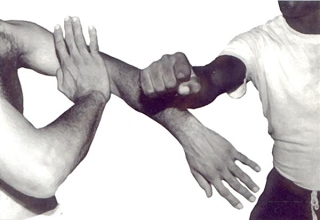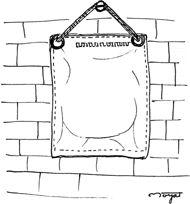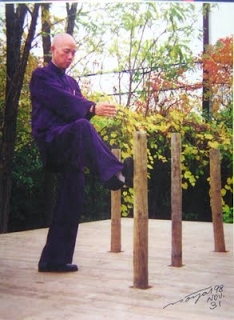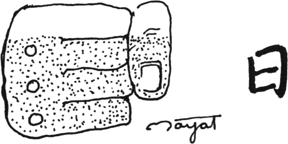By Aaron Vyvial | August 23, 2014
In addition to learning the Ving Tsun forms, a student will learn numerous exercises (known as two-person drills) which are designed to develop balance, coordination, energy, relaxation, sensitivity, and timing. These drills also serve to enhance a student’s understanding of Ving Tsun principles. Below are some of the two-person drills and hand/foot techniques typically taught to Ving Tsun students.
Two-Person Drills

Lop Sao Drill
Grabbing arm and quan sao position
Pak Sao Drill - Slap hand block and chain punch
Pak Dar Drill - Slap hand block with simultaneous counter punch
Don Chi Sao Drill - Single sticking arm chi sao
Luk Sao Drill - Rolling hands
Jip Sao Jow Sao - Running hands, catching hands
Lat Sao Jik Chung - Lost hand, flies forward
Tsui Ma - Moving horse or pushing horse drill
Chi Sao - Sticking hands, a free flowing exchange of techniques focusing on centerline theory
Cheung Chi Sao - High energy or “Bull” sticking hands
Chum Kiu Chi Sao - Long bridge sticking hands
Biu Je Chi Sao - Short bridge sticking hands
Luk Gerk - Sticking leg drill
Chi Gerk - Sticking legs drill
Maai Saan Jong - Free fight, not a drill so much as it is a test of abilities.
It’s sticking hands, not sticky hands.
“I don’t know much English. THIS word, I happen to know.” – Moy Yat, on ‘Sticking’ vs. ‘Sticky’ hands.
Kung Fu Family Terminology
Sifu - Used to refer to the teacher of the speaker’s generation, a Teacher, or a Master of the art. Also a father figure. It used to imply more of a master of the system, but now a days it just means “teacher” more than anything as many Sifus have not mastered the art.
SiGung - Teacher/grandfather, used to refer to your teacher’s teacher.
SiTaiGung - Your teacher/great-grandfather in the system.
SiJo - Grandmaster or Founder of the system.
SiMo - Wife of the Sifu.
SiSuk - Teacher/younger uncle, used to refer to the sidai of sifu, a student of the same generation as your sifu, but who has started later than your sifu has.
SiBak - Teacher/older uncle, used to refer to the sihing of sifu, a student of the same generation as your sifu, but who has started earlier than your sifu has.
SiDai - Younger brother, used to refer to a student of the same generation who has been studying for a shorter time than the person speaking. Seniority here is determined by the time spent in the school, not by the technical ability or level achieved – so, a student who has started after the speaker, but has surpassed him, would still be a sidai to the speaker.
SiHing - Older brother, used to refer to a student of the same generation who has been studying for a longer time than the person speaking.
In the Ving Tsun tradition, most titles do not have male and female distinction. For example: A SiHing or a Sifu can be a man or a woman.
Training Tools

Luk Dim Poon Kwan
The 6.5 Point Pole, a training device used to develop power and precision.

Muk Yan Jong (Moy Fah Jong)
The Wooden Man, a training device used to refine a practitioner’s techniques.

Sao Bao
The wall bag, a Ving Tsun training device used for striking and hand conditioning.

Gerk Jong
Wooden stumps or poles used for moving and kicking exercises.
Ving Tsun Hand Techniques

Yat Ji Chung Choi
“Sun Character Center Punch”. Used in the Chain Punch.
The world famous Ving Tsun punch is the one technique that characterizes and represents the Ving Tsun System. It uses an elbow pointing down vertical fist, using only the bottom 3 or 2 knuckles to strike. Instead of using shoulder rotation and strength, which is typical in most martial arts and boxing, the Ving Tsun punch borrows energy from the stance, hips, elbow and wrist to deliver an incredible amount of relaxed power.
From day one, the Chain Punch is trained so that the Ving Tsun student may be able to strike 10-12 times per second striking the exact same location in rapid succession. The elbow is kept down and inside the shoulders while punching for proper power generation and also for protection. Keeping the elbow pointed down during a punch will also block the line of attack for other incoming low and mid-level punches. The Ving Tsun punch is nicknamed “Sun Character Center Punch” because the fist travels down the centerline of attack and the horizontal fingers and square shape resemble the Chinese character for the sun. If there is one technique that represents Ving Tsun as a whole then it is the Yat Ji Chung Choi.
Jin Choi - Battle Punches
Dim Jearn - Palm Strike.
Wu Sao - Protecting Hand.
Lop Dar - Grab/trap hand and strike at the same time.
Wong Jearn - Side of Palm Strike
Biu Sao - Thrusting Hand. A nickname for faan sao movement within Biu Ji form.
Pak Sao - Slap Hand.
Poi Jearn - Cut Down Centerline
Poi Pai Jearn - Butterfly Palm Technique
Gaan Sao - Low Sweeping Hand.
Quan Sao - rotating hands.
Hyun Sao - Circle Wrist Hand.
Laan Sao - Fence Hand.
Jut Sao - Wrist Block Hand.
Chum Sao - forearm edge cutting hand.
Ging Sao - Side Block Palm Hand.
Jum Sao - Resting Hand.
Biu Je Jian - Vertical Elbow.
Chum Kiu Jian - Side Elbow.
Wu Jian - Guard Elbow.
Maan Sao - Asking Hand.
Ving Tsun Leg Techniques and Footwork
Dim Gerk - Front Kick.
Tan Gerk - Straight Block Leg.
Bong Gerk - Side Block Leg.
Fun Gerk - Stump Kick.
Yau Wang Gerk - Right Side Kick.
Joh Wang Gerk - Left Side Kick.
Kwai Saat - Kneeling Horse.
Hyun Ma - Circle Horse.

